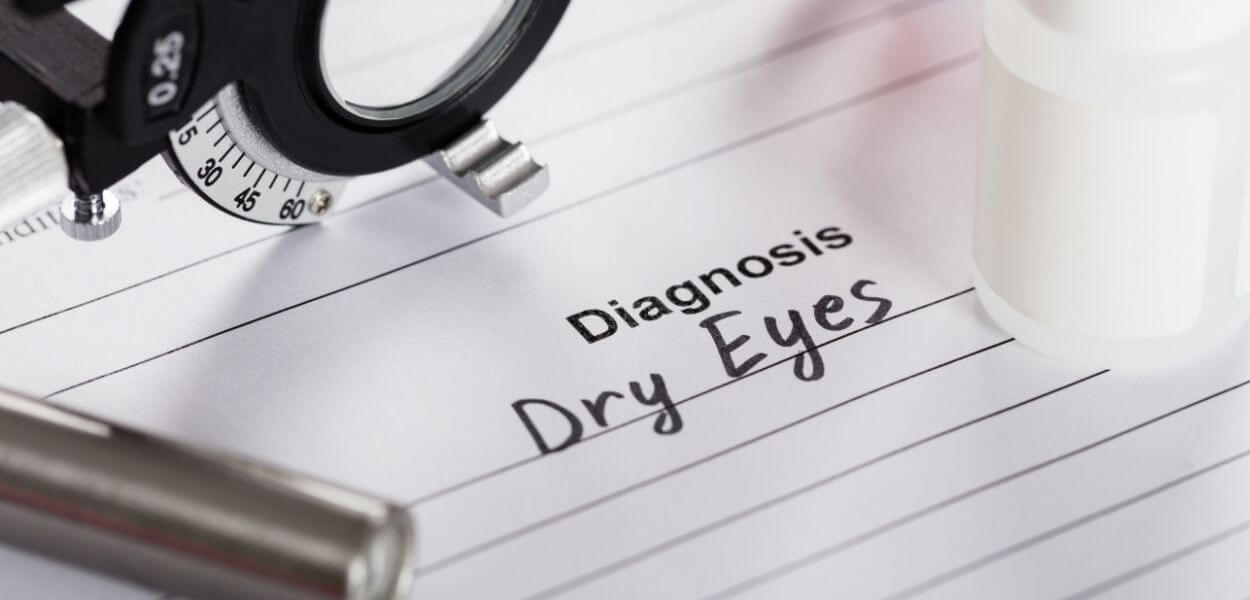Patients suffering from severe and chronic dry eye should consider prescription medication sooner rather than later. FDA-approved drugs meet strict safety standards and have shown efficacy across multiple clinical studies. These medications are effective and generally well-tolerated.
To get started, you may need a referral from your primary care physician. If not, schedule an appointment with a specialist. Testing helps physicians determine the nature of your condition, so familiarize yourself with the easy tests listed below:
- Comprehensive eye exam
- Tear volume measurement
- Tear osmolarity test
Depending on the cause of your chronic dry eye — whether it’s from inflammation, tear evaporation, or poor tear quality — different medications will be appropriate. The good news is there are many safe and effective options.

Xiidra: Non-Steroidal Eye Drops That Target Inflammation
Xiidra is a prescription eye drop approved by the FDA to treat the signs and symptoms of dry eye disease.1
Across all four clinical studies, participants with moderate to severe dry eye disease reported improvements after 12 weeks of consistent use. Symptoms were less severe and occurred less often.
Participants in two of the four studies experienced relief within two weeks.
How It Works
Over-the-counter eye drops, from artificial tears to thick gels, provide supplemental lubrication that temporarily alleviates symptoms. For patients with severe, chronic dry eye syndrome, self-care remedies are short-term solutions for a long-term problem.
Xiidra is not intended to mitigate symptoms of dryness. It is applied as an eye drop but is not a substitute for natural tears.
Instead, Xiidra deals with a specific cause of dryness and irritation in chronic patients: inflammation.
Xiidra blocks interactions between molecules that trigger an inflammatory response in eye tissues. The specific interaction and resulting inflammation are unique to chronic patients. This type of inflammation may be responsible for a wide range of moderate and severe dry eye symptoms.3-5
Quick Facts
- Manufacturer Recommended Dosing – Apply twice a day approx. 12 hrs. apart
- Uses – Non-steroidal and approved for long-term use
- Safety – Not approved for pediatric patients under 17
Xiidra is appropriate for patients with chronic dry eye who have not responded to self-care and therapies. Talk with your doctor for more information.
Restasis: Eye Drops For Ocular Inflammation
Restasis prescription eye drops cyclosporine, which is an immunosuppressant that increases tear production and reduces inflammation. It’s generally prescribed to patients suffering from chronic dry eye caused by inflammation.
How It Works
Some people suffer from chronic dry eye due to swelling in the eye, which decreases tear production.
The cyclosporine in Restasis is a modulator, meaning it regulates the immune system and specific inflammatory responses. Restasis reduces swelling in and around the eye and restores normal tear production.
One clinical study that looked at the efficacy of cyclosporine found significant improvement in dry eye patients by three measures: “blurred vision, need for concomitant artificial tears, and the physician’s evaluation of global response to treatment.”6
Overall, it rated cyclosporine a “safe and effective treatment.”
Quick Facts
- Manufacturer Recommended Dosing – Apply a single drop to each eye twice a day.
- Symptom Relief – Expect to wait three months for increased tear production, and six months for significant improvement
- Compatibility – Restasis is compatible with artificial tears and gels. Restasis recommends a 15-minute buffer between applying Restasis eye drops and OTC products.
Topical Corticosteroids: A Short Term Fix
Topical corticosteroids are steroidal eye drops used in moderate and severe dry eye cases. Compared to nonsteroidal anti-inflammatory eye drops (NSAIDs), topical corticosteroids are considerably more powerful and effective.
Corticosteroids work quickly, with noticeable changes taking place in just a few days. They are often prescribed for patients who have not had success with eye drops or artificial tears.
How it Works
Corticosteroids reduce inflammation, a major cause of chronic dry eye. In cases where NSAIDs don’t work, corticosteroids often do.
As one study found, “Topical corticosteroids had a clearly beneficial effect both on the subjective and objective clinical parameters of moderate-to-severe dry eye patients. These effects were associated with the reduction of inflammation markers of conjunctival epithelial cells.”7
“Reduction of inflammation markers of conjunctival epithelial cells” means “inflammation around the eyes.”
Quick Facts
- Manufacturer Recommended Dosing – Varies from medication to medication.
- Symptom Relief – Takes between 5-7 days, according to the manufacturer.
- Topical Corticosteroids – Mydrilate, Phenylephrine, and Mydriacyl.
Doxycycline: An Oral Antibiotic for Dry Eye
Doxycycline is an antibiotic with additional anti-inflammatory characteristics. For patients exasperated with eye drops, Doxycycline is an easy choice: time-tested and not dependent on your aim.
Doxycycline was discovered in the early 1960s. It remains in use to treat meibomian gland dysfunction and related symptoms.
How it Works
As an antibiotic, Doxycycline prevents the spread of bacteria. But unlike other antibiotics, Doxycycline has anti-inflammatory capabilities.
Doxycycline could be an attractive option for dry eye patients with more severe, chronic meibomian gland dysfunction.8 It also protects and hydrates the cornea. This medication is especially effective for patients with ocular rosacea.
Quick Facts
- Manufacturer Recommended Dosing – Take a 20 mg pill orally, twice a day.
- Symptom Relief – Use for three months unless positive results occur sooner.
- Additional Information – Go to our Self-Care page to learn more about meibomian gland dysfunction
Lacrisert: Lubricating Inserts for 24-Hour Relief
Lacrisert is a small, soft, and translucent rod-shaped insert designed to last all day, like extended-release artificial tears.
Lacrisert is typically prescribed for patients who have not responded to over-the-counter eye drops. These patients suffer from moderate to severe dry eye that is chronic.
How it Works
Lacrisert dissolves over the course of the day, and in the process, stabilizes the eye’s tear film. A stabilized and robust tear film protects the surface of the eye and improves tear retention in chronic patients.
In the morning, patients gently pull on each lower eyelid, placing a Lacrisert on the pink tissue underneath their lower eyelid (called the inferior cul de sac). Some people have reported issues properly placing the Lacrisert, but once it’s in, it dissolves.
Quick Facts
- Manufacturer Recommended Uses – Apply one insert daily. Some patients require two or as directed by a doctor.
- User Tips – Remove contact lenses before placing a Lacrisert. For added comfort, apply eye drops after inserting the Lacrisert.
- Side Effects – Can cause temporary blurred vision. Consult your doctor to learn about the side effects of all medications we’ve mentioned in this post.
References
1. US Food and Drug Administration. FDA approves new medication for dry eye disease. Published July 12, 2016. Accessed May 1, 2020. https://www.fda.gov/news-events/press-announcements/
fda-approves-new-medication-dry-eye-disease
2. Xiidra [package insert]. East Hanover, NJ: Novartis Pharmaceuticals Corp; June 2020.
3. Perez VL, Pflugfelder SC, Zhang S, Shojaei A, Haque R. Lifitegrast, a novel integrin antagonist for treatment of dry eye disease. Ocul Surf. 2016;14(2):207-215.
4. Pflugfelder SC, Stern M, Zhang S, Shojaei A. LFA-1/ICAM-1 interaction as a therapeutic target in dry eye disease. J Ocul Pharmacol Ther. 2017;33(1):5-12.
5. Bron AJ, de Paiva CS, Chauhan SK, et al. TFOS DEWS II Pathophysiology Report. Ocul Surf. 2017;15(3):438-510.
6. Pan Q, Angelina A, Marrone M, Stark WJ, Akpek EK, and Cochrane Eyes and Vision Group. Autologous serum eye drops for dry eye. 2017 Feb; 2017(2). https://www.ncbi.nlm.nih.gov/pmc/articles/PMC5510593/
7. Avunduk AM, Avunduk MC, Varnell ED, Kaufman HE. The comparison of efficacies of topical corticosteroids and nonsteroidal anti-inflammatory drops on dry eye patients: a clinical and immunocytochemical study. Am J Ophthalmol. 2003;136(4):593-602. doi:10.1016/s0002-9394(03)00326-x
8. Yoo SE, Lee DC, Chang MH. The effect of low-dose doxycycline therapy in chronic meibomian gland dysfunction. Korean J Ophthalmol. 2005;19(4):258-63.
